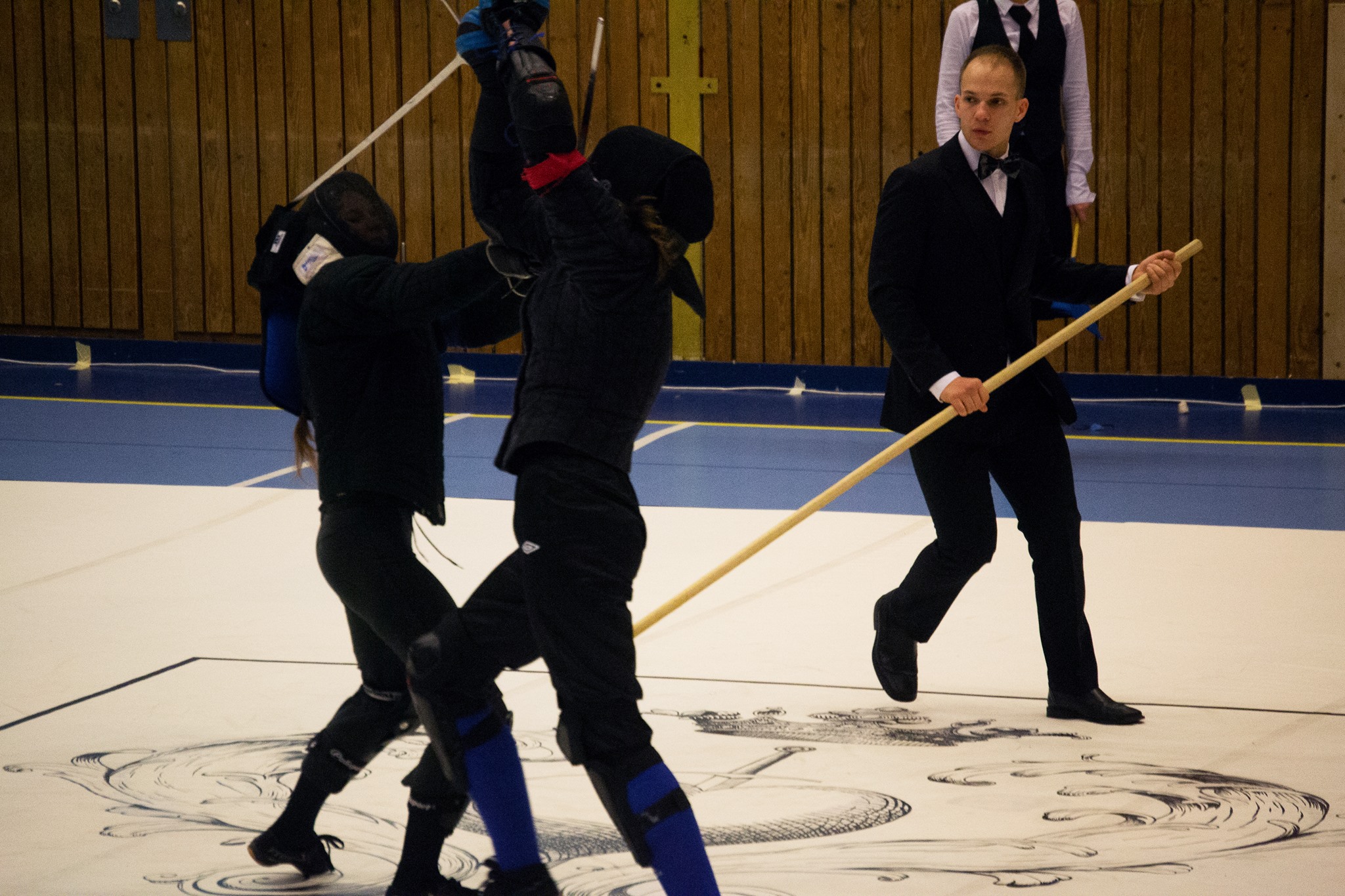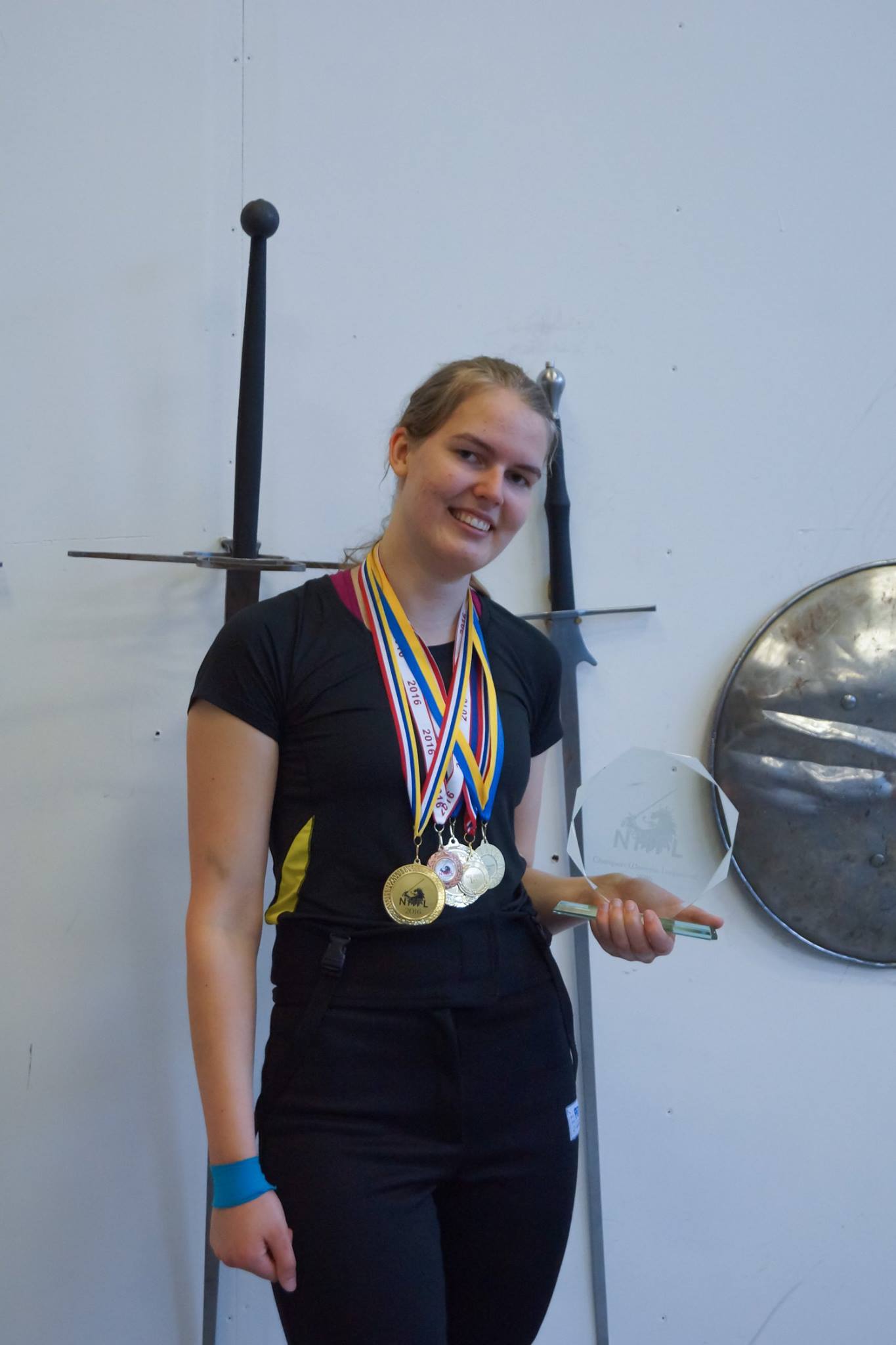
Written by Claudia Krause |
Sara Vertanen, 21 year old longsword champion from Finland, has been more than successful in the last 12 months. In 2015 she won the women’s longsword competition at Swordfish, our unofficial World Championship. This year she became Nordic Historical Fencing League Champion of the women’s longsword division, with a very clear margin. Just yesterday she scooped up a gold in the Dutch Lions Cup. How did she become such a dominant longsword fighter in Europe? Sara isn’t exactly dying to give impromptu interviews. Some may have noticed that she did not appear in the Swordfish live-stream for a statement after her win. However, she kindly answered some questions on-line to enlighten us.
Sara was born in Jyväskylä, a city of just under 140,000 inhabitants in central Finland, about 234 km (145 miles) from Helsinki, as the crow flies. When she first came in contact with HEMA in 2011, Sara was no stranger to sports. She had played Finnish baseball for 6 or 7 years, and was still training volleyball regularly . When a classmate in high school found an advert for a beginner’s course with the JHMS (Jyväskylä Historical Fencing Club), several friends, including her, signed up.
She was still training with JHMS, when Eliisa Kuusama (then Keskinen) sent her a message 2 weeks before the 2015 Helsinki Longsword Open. Eliisa Keskinen is a household name known to many, as two time gold medalist in women’s longsword at Swordfish herself, vocal supporter of women’s tournaments in HEMA, instructor at EHMS and contributor to the Nordic fencer blog.
So when Eliisa suggested she might be interested in the women’s longsword competition, Sara said yes. That was her first time in the arena. She didn’t start by winning all her pool fights, let alone getting anywhere near a medal. But she ended up fighting all Nordic League competitions that year, all the while making visible progress.
In autumn last year she moved to Espoo, near Helsinki to start a 3 year degree course in security management. It was mere coincidence that Eliisa happened to follow the same course, albeit in a different year. Alternatively, we speculate, there must be something about the longsword inspiring this choice of career…
Espoo is a large city next to Helsinki. Together with yet another city, Vantaa, they are referred to as “capital city area”. Espoo is also home to one of Finland’s most prominent HEMA clubs, the EHMS (Espoo Historical Fencing Club). EHMS was founded and originally located in Espoo, then relocated to Helsinki. This caused some consternation regarding the “E” in the club name, but attempts to change it failed. Presently training has moved to Espoo again, which has resolved the the name conundrum for now.
Whatever its name troubles, EHMS is certainly known for first-tier HEMA competitors and instructors. Besides Eliisa, Kristian Ruokonen has scooped many medals both sides of the Atlantic. He was one of the major players in causing a minor identity crisis in US HEMA by dominating the competitions a few years ago at “Longpoint”, the largest international HEMA event in the USA. It is fair to say, he is equally feared and welcomed in HEMA circles wherever he goes. Matias Parmala, Sara’s principal coach, is not only co-founder and instructor of the EHMS, but one of Finland’s finest longsword fencers. Illka Hartikainen heads a whole host of excellent swordfighters of the Bolognese tradition. This environment has proven very valuable to her. She is rarely thoroughly satisfied with her own performance and has experienced “dry spells” where she did not quite enjoy training or competing.
“Luckily I have a very supportive club full of inspiring and talented people. That motivates me to keep on practicing. It also helps that I have a very good coach, Matias. He was coaching me through this year’s Nordic Historical Fencing League. He has pushed me to my best performance yet and talked to me whenever I was ready to quit.”
This year’s NHFL competition provided quite a mental challenge for her: “After winning the first competition I thought that I might have a tiny chance of winning the whole league. When I got bronze in the third competition in Copenhagen I actually calculated many, many times what needed to do to still win the whole league. I found it very challenging to keep my head in the game. And yes, it was extremely rewarding to step on the podium after the last league competition, Sweden Open, as overall winner. It felt like that my training had gone in the right direction.”

As it turns out, she would have needed to do nothing after the third competition to emerge as overall winner. But instead she won gold in the Sweden Open as well. That is nothing if not true dominance. But it is very comforting to know that even outstanding fighters suffer from the self doubts and “nerves”.
And Sara has her share of it: “I do stress a lot about competing and being successful in it. It’s easier to not stress if you don’t go. But I always find myself signing up in the end. To be honest, I hate competing, but at the same time I love it. It is hard to explain, but some kind of love hate-relationship.”
Sara told us that competing itself has changed her attitude to training. She trains harder to learn new techniques to a level that she can use them with an uncooperative partner. She also has started to run and lift weights, in order to become “the best fencer she can be”.
So what does she think are the most important attributes to become a good HEMA fighter?
“First of all, you must be passionate. You have to be prepared to spend lot of time training. You have to have patience and be hard headed, even, because there will be times when nothing is working and you feel like you’re stuck.”
But Sara does know that nobody is an island, and hastens to remind us:
“From personal experience, no one can become the best HEMA fighter they can be on their own. You need to have good, reliable support behind you. Those who push you all the time to perform even better. You also have to be humble. You can’t always win. Someone will eventually beat you.”
Sara has stayed humble herself. As formidable as she is as a fighter, as personable and calm she is in real life. We wish her a long and happy HEMA career, both in and out of the arena.
She wouldn’t humour us to invent a battle cry for herself, because “I’m a Fin. I don’t show that much emotion”. We, however, will be sure to cheer plenty for her, next time we see her fight. It turns out she has registered for swordfish this year again. The Swordfish life-stream is a definite possibility then!
The author of this article is wholly responsible for its content.
